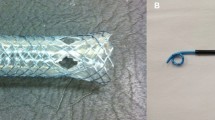Abstract
Introduction
Colorectal surgery is complicated by postoperative collections in up to 25% of cases depending on local conditions. The aim of this study was to identify predictive factors of success of percutaneous drainage of collections in order to avoid follow-up imaging.
Patients and methods
All consecutive patients between January 2009 and December 2016, who had undergone elective or emergency colorectal surgery (colorectal surgery and appendectomy) complicated by a postoperative collection treated by percutaneous drainage with follow-up imaging prior to drain removal, were included in this single-center and retrospective study. The primary objective was to assess predictive factors of success of the first attempt of percutaneous drainage of collections. Secondary objectives were to describe the natural history of percutaneous drainage of postoperative collections after colorectal surgery and the overall success rate of percutaneous drainage.
Results
Fifty-three patients underwent percutaneous drainage of a postoperative collection during the study period and were included in this study. Complete resolution of the collection was observed on the first follow-up radiological examination in 36 patients (58%). In multivariate analysis, post-appendectomy collections (OR = 3.19 (1.14–9.27), p = 0.002) and reduction of the leukocyte count (OR = 3.22 (1.28–8.1), p = 0.013) were significantly associated with success of percutaneous drainage.
Conclusion
This is the first study to address that follow-up imaging prior to drain removal might not be necessary in patients undergoing drainage of post-appendectomy collections and/or with more than 30% reduction of the leukocyte count at the first follow-up examination.
Similar content being viewed by others
References
Kartheuser AH, Leonard DF, Penninckx F, Paterson HM, Brandt D (2013) Waist circumference and waist/hip ratio are better predictive risk factors for mortality and morbidity after colorectal surgery than body mass index and body surface area. Ann Surg 258:722–730
Baig MK, Zhao RH, Batista O, et al. (2002) Percutaneous postoperative intra-abdominal collection drainage after elective colorectal surgery. Tech Coloproctol 6:159–164
Cinat ME, Wilson SE, Din AM (2002) Determinants for successful percutaneous image-guided drainage of intra-abdominal collection. Arch Surg 137:845–849
Laganà D, Carrafiello G, Mangini M, et al. (2008) Image-guided percutaneous treatment of abdominal-pelvic collections: a 5-year experience. Radiol Med (Torino) 113:999–1007
Akinci D, Akhan O, Ozmen MN, et al. (2005) Percutaneous drainage of 300 intraperitoneal collections with long-term follow-up. Cardiovasc Intervent Radiol 28:744–750
Politano AD, Hranjec T, Rosenberger LH, Sawyer RG, Tache Leon CA (2011) Differences in morbidity and mortality with percutaneous versus open surgical drainage of postoperative intra-abdominal infections: a review of 686 cases. Am Surg 77:862–867
Hemming A, Davis NL, Robins RE (1991) Surgical versus percutaneous drainage of intra-abdominal collections. Am J Surg 161:593–595
Olak J, Christou NV, Stein LA, Casola G, Meakins JL (1986) Operative vs percutaneous drainage of intra-abdominal collections. Comparison of morbidity and mortality. Arch Surg 121:141–146
Kassi F, Dohan A, Soyer P, et al. (2014) Predictive factors for percutaneous drainage of postoperative collection after abdominal surgery. Am J Surg 207:915–921
Okita Y, Mohri Y, Kobayashi M, et al. (2013) Factors influencing the outcome of image-guided percutaneous drainage of intra-abdominal collection after gastrointestinal surgery. Surg Today 43:1095–1102
Benoist S, Panis Y, Pannegeon V, et al. (2002) Can failure of percutaneous drainage of postoperative abdominal collections be predicted? Am J Surg 184:148–153
Robert B, Yzet T, Regimbeau JM (2013) Radiologic drainage of post-operative collections and collections. J Visc Surg 150:S11–S18
Golfieri R, Cappelli A (2007) Computed tomography-guided percutaneous abscess drainage in coloproctology: review of the literature. Tech Coloproctol 11:197–208
Theisen J, Bartels H, Weiss W, et al. (2005) Current concepts of percutaneous collection drainage in postoperative retention. J Gastrointest Surg 9:280–283
Rotman JA, Getrajdman GI, Maybody FM, Boas E (2016) Effect of abdominopelvic collection drain on drainage time and probability of occlusion. Am J Surg 70:27–28
Author information
Authors and Affiliations
Corresponding author
Rights and permissions
About this article
Cite this article
Brac, B., Sabbagh, C., Robert, B. et al. Natural history of percutaneous drainage of postoperative collection following colorectal surgery: in which patients can follow-up imaging be dispensed with before drain removal?. Abdom Radiol 44, 1135–1140 (2019). https://doi.org/10.1007/s00261-018-1811-x
Published:
Issue Date:
DOI: https://doi.org/10.1007/s00261-018-1811-x




